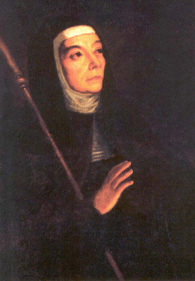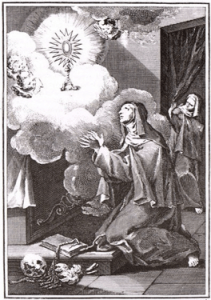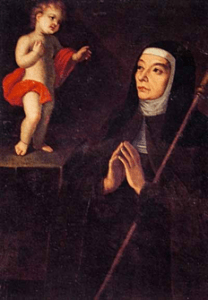Capuchin Poor Clare (1592-1665)

Maria Angela was born in Barcelona, Spain on 1stSeptember 1592. She joined the Capuchin Poor Clares at age 11 but had to wait five years to be admitted to the Cloister because of her age. A year later she made her solemn profession on the feast of the Nativity of Our Lady in 1609. In 1614 she was sent to Saragossa as novice-mistress. In 1627, Pope Urban VIII approved the Constitutions of the Spanish Capuchin Poor Clares and she was named Abbess for a period of three years. In 1645, she took part in the foundation of the Murcia Monastery. For sixteen years she was in charge of those in their initial formation and abbess of this monastery. Maria Angela had extraordinary contemplative experiences, nourished by meditation on the Liturgy of the Hours. She had special devotion to the Passion of Our Lord, and was always full of charity and concern for her sisters. Maria Angela died at Murcia at the age of 73 years on 2ndDecember 1665, while singing the “Pange Lingua”. She was beatified by Saint John Paul II on 23rdMay 1982.
Jerónima Maria Agnese, born 1 September 1592 in Barcelona, was the last of four children born to Cristobál Astorch and Caterina. She had no time to know her mother who died twelve months later. Entrusted to a nurse, she was orphaned of her father at the age of five or six years. Her sister Isabel followed a group of young people attracted by the spirituality of the Capuchin Poor Clare Angela Serafina Prat. Even the little Jeronima was quickly caught up in this phenomenon – more so when she was seven years old. After eating bitter almonds she was at death’s door and arrangements were being made for her funeral. Mother Serafin intervened. In an ecstasy she restored the little girl to life. Later she would write, “My childhood ended when I was seven. From then on I was already a judicious and adroit woman, and therefore patient, measured, silent and truthful.”
Her tutors had her study when she was nine. She learned to read and write as well as the usual work assigned then to women. She displayed a real passion for books, especially books in Latin. He teacher was filled with admiration. Therefore great plans were made for her future. She, however, wanted to follow the example of her sister and asked entry to the monastery. After some concerns with the relatives, and given her advanced maturity for her eleven years of age, she was able to realise her desire. On 16 September 1603 she crossed the threshold of the enclosure, taking with her the six volumes of the Latin breviary that she could read perfectly. In her investiture she received the name Maria Angela. An expert confessor, Martin Garcia, who had lived as a hermit for ten years, accompanied her on her spiritual journey. She sought to imitate the founder, Angela Serafina Prat, and her sister Isabel. The master of novices, sister Vitoria Fábregas was rigid and used Spartan methods in her dealings with the girl. He love for Latin books, well above that of her age, provoked some fear regarding the humility of the novice. So she had to resign herself to not using Latin books anymore. However, Latin flowed from her lips with such a knowledge of the Sacred Scriptures, the Fathers and the Breviary which later convinced theologians and even some bishops that hers was an infused knowledge.
She had to spend five years as an aspirant, the baby of the house, though following the novitiate regimen. On 7 September 1608 she began the novitiate proper under the balanced and detached direction of her sister as novice master. Afflictions and temptations were not lacking. Because of her superior learning, she had to carry out the role of ‘little teacher’ of her novitiate companions. On 8 September 1609 she made profession into the hands of Sister Caterina de Lara, the successor to the founder who had died the previous year and she continued her spiritual journey for another five years.
Meanwhile, the new Capuchin congregation expanded at a lively rate. Mother Maria Angela, with five other sisters, were sent to found a monastery at Zaragoza, destined to become the hub from which the Capuchin Poor Clares spread throughout Spain. On 19 May 1614 this group of sisters went straight for Zaragoza. Sister Maria Angela had the task of novice master and secretary. However, separation from her sister cost her dearly. Her sister would die just two years later at only thirty six years of age. The journey was disastrous. The carriage and horse overturned. In the new monastery of Our Lady of the Angels, Maria Angela became the formator of a generation of Capuchin Poor Clares.
In 1624 she became vicar, and abbess three years later. However she always remained ‘choir corrector’, the one responsible for the correctness of the ceremonies and of the dignity of the liturgy of the hours in the community. At the beginning of her office as abbess she obtained approval from Urban VIII for the constitutions of the Capuchin Poor Clares of Spain. Conscious of the importance of knowledge of its rule for the sanctification of any institute, she insisted that he sisters study the rule continuously. In her monastery the rule was read publicly in the refectory at the beginning of each month so that even the illiterate sisters could learn it. In her spiritual conferences she spoke so well and with such unction that one bishop came to the point of regretting that she was not a priest. She was a mother who did not spare herself, ready for every kind of work in the kitchen, the laundry, the infirmary or the garden.
When asked why she did this she answered, “Because I would even give you my life.” She shared the monastery alms with the poor and generously helped the needy with the little that the monastery had. When Zaragoza was invaded by ragged refugees from the rebellion in Catalonia, she distributed among some beggars the clothes that the novices had brought with them when they left home. Her spirituality deepened even further, a spirituality was completely biblical and liturgical. All the mysteries of Christ and of Mary, the angels and the saints found a profound resonance in her heart with visions and heavenly insights.
 She used to address the saints with great familiarity. Among them she had twelve favourites whom she called her “heavenly consistory” – teachers and advocates for the virtues and for concrete needs. They were Saint John the evangelist, a model of love; Saint Francis of Assisi in perfect faithfulness to the Rule; Saint Benedict for purity; her holy mother Saint Clare in every form of perfection. The Breviary continued to inspire and encapsulate her spiritual life ever more progressively. In 1642 she wrote, “It happens to me very, very often that while singing the psalms the Lord communicates with me through interior sensations that which I am signing is such a way that I can say that I am truly singing the internal feelings of my spirit and not the letter of the psalms. It seemed to me that Lord had made himself my teacher and expounder of what I was saying and singing, enabling me to understand some of the infinite truths of the Sacred Scripture.”
She used to address the saints with great familiarity. Among them she had twelve favourites whom she called her “heavenly consistory” – teachers and advocates for the virtues and for concrete needs. They were Saint John the evangelist, a model of love; Saint Francis of Assisi in perfect faithfulness to the Rule; Saint Benedict for purity; her holy mother Saint Clare in every form of perfection. The Breviary continued to inspire and encapsulate her spiritual life ever more progressively. In 1642 she wrote, “It happens to me very, very often that while singing the psalms the Lord communicates with me through interior sensations that which I am signing is such a way that I can say that I am truly singing the internal feelings of my spirit and not the letter of the psalms. It seemed to me that Lord had made himself my teacher and expounder of what I was saying and singing, enabling me to understand some of the infinite truths of the Sacred Scripture.”
She lived in Zaragoza thirty years. The community grew in number and quality and already it had insufficient space. Maria Angela’s desire to propagate the Order was realised following a sacrilegious and wicked act that occurred in Barcelona thanks to the troops of Louis XIV who had profaned some churches. A pious canon, Alejo de Boxadós thought of building a Poor Clare Monastery in reparation. It would have the title of “Exaltation of the Blessed Sacrament.” He contacted the Capuchin Poor Clares. On 2 June 1645 five sisters under the guidance of Maria Angela Astorch went to Murcia with the canon. This time too the journey was a disaster. The coach driver fell asleep and then fell under the wheels of the coach. Only the faith of the sisters revived him and so they continued on. A solemn procession inaugurated the new monastery of the Blessed Sacrament in Murcia, in accord with the sentiments of Blessed Maria Angela who saw all of Christology summed up in the Eucharist. She succeeded in having the practice of daily Communion introduced among her sisters.
The monastery became a centre of spirituality. During the raging plague in 1648 the sisters were spared just as they were spared from the periodic floods of the Segura River in 1651, even if the monastery suffered greatly. The sisters had to take refuge in the summer residence of the Jesuits in the mountains for thirteen months while waiting for the monastery to be restored. They returned to the monastery on 22 September 1652, only to have to return a year later to the mountains because of another flood. A defamatory accusation spread about by a rumour monger was a difficult test for Blessed Maria Angela, however her innocence was quickly proven.
On finally returning to the monastery she continued in the office of abbess until 1661. Now in her seventies she would have wanted to step down completely to be “sola con il Solo” (alone with Him alone). She obtained the grace of becoming ineligible for the performance of various works and so could give herself entirely to the contemplative life. In mid November 1665, follow some episodes of epilepsy, she regained her memory and intelligence. However, this was the end. She felt crucified. Sometimes she would sing the Pange lingua while waiting for her “bridegroom” [“blood bridegroom” cf. Ex 4:24] who came for her on 2 December 1665 when she was seventy five years old.
 The ordinary process opened three years later in the diocese of Cartegna-Murcia. After a long silence the process re-opened in 1688 and has continued to present times. Her incorrupt body, which was profaned during the Spanish Civil War (1936-1939) is now kept in the new monastery in Murcia. On 23 May 1982 John Paul II declared her blessed. For those who wish to learn of her mystical experience, they may read her marvellous writings. They are quite modern in their style and very agreeable. They have been published in one volume by Lazaro Iriarte, Mi camino interior. Relatos autobiográficos, Cuentas de espíritu, Opúsculos espirituales, Cartas, Madrid, 1985. With good reason she may be considered as one of the more important links in the history of devotion to the Child Jesus, to the Sacred Heart, the Eucharist, to the Passion and Christ the Good Shepherd from which springs the totally Capuchin Marian spirituality of the “Divine Shepherdess” or Divina Pastora.
The ordinary process opened three years later in the diocese of Cartegna-Murcia. After a long silence the process re-opened in 1688 and has continued to present times. Her incorrupt body, which was profaned during the Spanish Civil War (1936-1939) is now kept in the new monastery in Murcia. On 23 May 1982 John Paul II declared her blessed. For those who wish to learn of her mystical experience, they may read her marvellous writings. They are quite modern in their style and very agreeable. They have been published in one volume by Lazaro Iriarte, Mi camino interior. Relatos autobiográficos, Cuentas de espíritu, Opúsculos espirituales, Cartas, Madrid, 1985. With good reason she may be considered as one of the more important links in the history of devotion to the Child Jesus, to the Sacred Heart, the Eucharist, to the Passion and Christ the Good Shepherd from which springs the totally Capuchin Marian spirituality of the “Divine Shepherdess” or Divina Pastora.
Translation based on Costanzo Cargnoni, Sulle orme dei santi, 2000, p.273-282.
From the writings of Blessed Maria Angela Astorch
An unpublished manuscript n the archives of the General Postulator OFM Cap
Mother and servant of the sisters
It is the greatest mortification for me to find myself the superior and having to give orders, especially because I am responsible for the spiritual progress of the sisters. I heard the Lord telling me inwardly: “In everything you do, make yourself an example to them”, and from this I have never ceased to learn more about my obligation to be an example to the that governance involves, as a servant in the Lord’s house and judging myself unworthy to be among his servants.
I know very well that the Lord does not lead everyone by the same route, and that therefore l have help them, gently and kindly, to at the pace which He has decided fo each one, without trying to regiment them and direct them all in the same way. My usual way of acting is to do everything under the gaze of my divine Lord. If I suffer I accept it, exercise patience, and say nothing, I renounce my owns pleasure, my ‘will, and way of understanding, I consent to the opinion of others and give way humbly in matters of little consequence. I revere in my sisters that hidden holiness which God has infused in their souls. I accept the way they are, knowing that we are all fragile vessels. I am not surprised by their weaknesses, in fact I suffer with them, because weakness can hinder growthh in holiness and in the service of God, and it is an unworthy thing to serve without great holiness, purity and humility. This is why I carry this burden with them.
I long for all my sisters to enjoy what I feel and enjoy when the Lord communicates with me in the depths of my heart and makes me grow in the virtues. My wish is that this should happen without my klnowledge, or rather suddenly and without warning, as an effect of that inner joy which is at work in the heart of each person, whilst I remain humiliated, annihilated in my nothingness, which is always the same whether God wishes it or permits it. Many times I have deprived myself of my spiritual sustenance in order to give it to them, taking delight in the encouragement and consolations they received from it.
I try to adapt myself to each person’s condition and nature, and also to provide for their needs, although I do not find this easy. As for their failings and their faults, they seem very slight to me, compared with my own. However, out of respect for the truth, I cannot approve faults or carelessness. I excuse them; but, since I have to take care of them I make sure they correct themselves and strive to give good example, both externally and above all in the sight of God, and to fulfil their obligations as our state of life requires and the practice of virtue demands.
I am constantly striving to die to myself, offering my life as a sacrifice to my divine Lord. And there is no lack of opportunities for me to do this, because I am offering myself to them, like tasty food prepared for each one. But this is not so effortless that nature does not , on various occasions, feel many difficulties and want to rest and avoid this cross and wish it did not have to die so many times in the sacrifices that my will is obliged to make. I overlook things of little importance and do not worry if people do the opposite of what I feel and desire. Adapting myself to each person’s character is, without a doubt, the work of grace.
I carry them all in my heart. I love them so much that, if it were necessary, I would give my life for each one of my daughters. In fact, for the sake of their holiness, I would give it publicly, on the most shameful of gallows.
Prayer
O God,
rich in mercy to those who call upon you,
you gave Blessed Maria Angela the grace
to fathom in ways beyond words
the secrets of your riches
in the daily liturgy of praise.
Through her intercession,
may all that we do be done for you,
for the praise of your glory,
in Christ Jesus your Son,
who lives and reigns with you and the Holy Spirit,
one God, for ever and ever. Amen.
